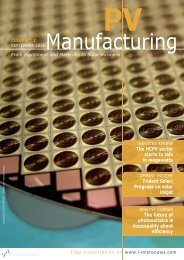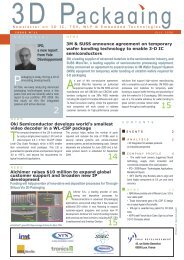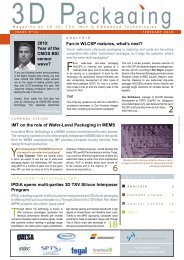Two very different approaches to MEMS packaging - I-Micronews
Two very different approaches to MEMS packaging - I-Micronews
Two very different approaches to MEMS packaging - I-Micronews
You also want an ePaper? Increase the reach of your titles
YUMPU automatically turns print PDFs into web optimized ePapers that Google loves.
F e b r u a r y 2 0 1 3 I S S U E N ° 2 6<br />
INDUSTRY REVIEW – FOCUS ON POWER DEVICE PACKAGING<br />
New <strong>packaging</strong> technology<br />
and new business models impact<br />
power module design<br />
Potential volume markets in alternative energy applications have attracted<br />
investment in<strong>to</strong> both new <strong>packaging</strong> technologies and new business models that<br />
could have a big impact on the power device market. We check in with International<br />
Rectifier on technology for replacing wire bonding with modular solderable<br />
components, and with iQXPRZ on the rise of the fabless/foundry option.<br />
The potentially high volumes and extreme<br />
performance demands of the hybrid and<br />
electric vehicle market will have significant<br />
impact on power device technology. One recent<br />
example of the innovation being driven by this<br />
market is International Rectifier’s new modular<br />
IGBT and diode co-pack building block that can<br />
be surface mounted in <strong>different</strong> combinations,<br />
simplifying power module construction and allowing<br />
systems makers <strong>to</strong> more easily create their own<br />
optimized power circuit <strong>to</strong>pologies.<br />
IR has replaced the wire bonds with solderable<br />
metal on both sides of the thin IGBT and diode<br />
dies, and attached both <strong>to</strong> a direct bonded copper<br />
substrate. These pre-assembled and pre-tested<br />
building blocks are then attached <strong>to</strong> a DBC—singly<br />
or in multiples, either face up, or face down flip-chip<br />
style for shorter connections and flexible design.<br />
Eliminating the wire bonds improves reliability<br />
and makes a more compact device, while the<br />
IGBT and diode dies with solderable metal on both sides can be easily assembled in<strong>to</strong> co-packs<br />
and modules. (Courtesy of International Rectifier)<br />
double-sided cooling signifiantly improves thermal<br />
performance. After attaching the leadframe, this<br />
compact unit is then overmolded. Compared <strong>to</strong><br />
a conventional module wirebonded in a gel-sealed<br />
plastic package, this process adds a <strong>to</strong>p layer of<br />
DBC, but eliminates the wirebonds, gel and base<br />
plate, although a base plate can be added as an<br />
option.<br />
Jack Marcinkowski, Sr. Technical Marketing and<br />
Applications Manager for International Rectifier’s<br />
Au<strong>to</strong>motive Business Unit, says this buildingblock<br />
approach significantly reduces overall<br />
system cost, by improving mechanical, electrical<br />
and thermal performance, but especially by<br />
providing a standardized and tested building block<br />
that simplifies power module cus<strong>to</strong>mization and<br />
assembly and improves yields. IR will both use the<br />
technology in its own modules and sell the devices<br />
<strong>to</strong> outside cus<strong>to</strong>mers.<br />
“This intermediate co-pack fills the gap between<br />
discretes and modules,” he says, noting that the<br />
compact modules can replace a number of discrete<br />
packaged devices. “There’s no precedent in the<br />
industry. Manufacturers can use the co-pack like<br />
a surface-mounted component <strong>to</strong> create their own<br />
optimized cus<strong>to</strong>m <strong>to</strong>pology, instead of trying <strong>to</strong><br />
design their system around an existing commercial<br />
module.” The compact module is reportedly<br />
roughly half the size and a quarter of the weight of<br />
a similarly-rated wire-bonded gel package, opening<br />
design possibilities such as putting the inverter<br />
inside the electric mo<strong>to</strong>r housing, for example.<br />
Key <strong>to</strong> the development was selecting proper<br />
device metallization, die attach, materials with<br />
well matched thermal expansion properties,<br />
and devising a high yielding manufacturing<br />
process. The company says the payoff is major<br />
improvements in performance for EV/HEV inverter<br />
demands. Marcinkowski reports the devices have<br />
held up through some one million thermal cycles so<br />
far in company tests, while wirebonds—the most<br />
common failure mechanism for power devices—<br />
may start <strong>to</strong> crack or delaminate at 100,000 cycles.<br />
10 3 D P a c k a g i n g
















